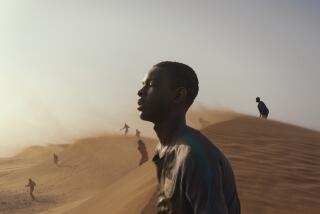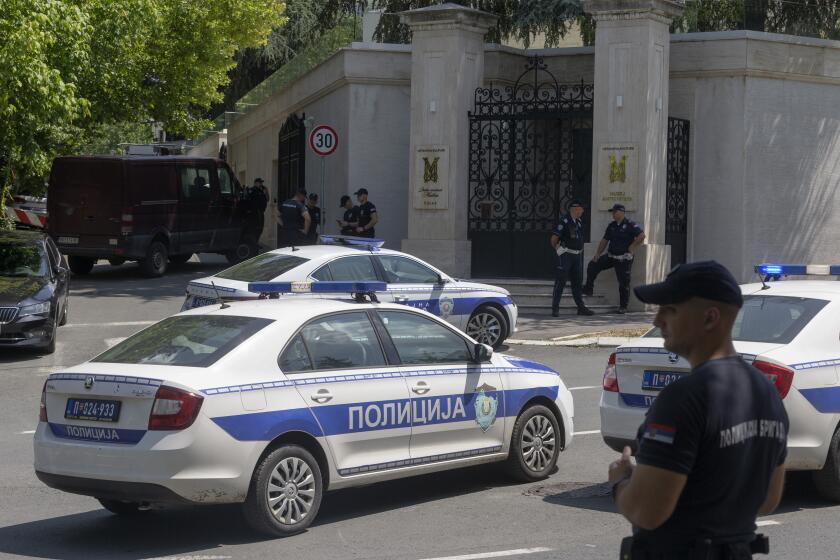In Libya, a long-dead hero rises again in east
In eastern Libya, the spectral image of an elderly, bearded man in a skullcap or Bedouin cloak is everywhere — on bumper stickers and posters, military vehicles and checkpoints, even press IDs issued by the rebel government here.
“He is the godfather of all of us,” said Salim Ismael, a retired army officer now training rebel recruits. “He is our inspiration, the spiritual leader of the Libyan revolution.”
The figure is Omar Mukhtar, a 20th century resistance hero executed by Italian occupiers 80 years ago — and, improbably enough, depicted in a 1981 Hollywood all-star epic, “The Lion of the Desert,” starring Anthony Quinn as Mukhtar. A box-office flop, the film has a devoted cult following here.
“General, bring me back Mukhtar!” Rod Steiger, playing Benito Mussolini, bellows to a subordinate before dispatching him across the Mediterranean. “Bribe him or break his neck.”
Mukhtar is a kind of Libyan Che Guevara, another doomed revolutionary, but without the Cold War baggage and crass commercialization.
Here in the east, where he based his guerrilla war so long ago, Mukhtar has displaced the once-omnipresent likeness of Moammar Kadafi, who has been relegated to crude caricatures as a murderer, madman and Zionist stooge.
The clashing iconography says much about the profound changes that have swept this North African nation in just a few months.
Libyan insurgents are fighting a war for control of their vast, oil-rich country, but they are also keen to reclaim their national pride and history after more than four decades of submission to Kadafi’s mercurial vision. Even though the war is mired in an uneasy stalemate, a sense of psychological liberation abounds in the east, where the guerrilla-vs.-tyrant theme resonates deeply.
And a humble teacher-turned-freedom fighter who swung from the gallows long before most people here were born has come to epitomize it all.
“Omar Mukhtar is a symbol for everything that we are living through at this time,” said Athia Makzoum, a historian at the University of Garyounis in Benghazi who has studied Mukhtar’s life. “Mukhtar is one Libyan of whom we can all truly be proud.”
Even Kadafi embraced Mukhtar — up to a point.
The Libyan leader put his image on the 10-dinar note and, in a rare display of modesty, placed his own face on the 1-dinar bill.
Kadafi also financed much of the $30-million cost of “The Lion of the Desert,” a kind of Arab “Ben Hur” filmed mostly in the Libyan desert and Rome. The two-hour-40-minute film features almost nonstop battle sequences: exploding tanks, assaults on horseback, a blown-up bridge or two. The central protagonists are Mukhtar and Rodolfo Graziani (played by Oliver Reed), the Italian general who shares Il Duce’s drive to restore the triumphs of the Caesars.
Even though the general and Mukhtar are implacable adversaries, the cultured Italian comes to acknowledge a grudging respect for the Libyan.
“This old man is good,” Graziani sighs after observing through field glasses as Mukhtar’s men on horseback wipe out an entire Italian column in a brilliant desert ambush.
After Mukhtar is captured, the two rivals finally meet in the general’s elegant offices in Benghazi. The captive dismisses an offer to become an Italian pensioner.
“Money, like glory, is not permanent,” Mukhtar says. “We will never surrender. We win or we die.”
You will be hanged publicly the following day, the general declares.
“The rope of your justice is always hanging in front of me, general,” Mukhtar replies.
Neither history nor Google records what Kadafi thought of the film. But opponents in Benghazi, the rebel stronghold, say the man who dubs himself “the leader of all leaders of the Arabs” and “the king of all the kings of Africa” eventually became uncomfortable with the notion of another Libyan vying for the hearts and minds of his subjects. Even a long dead one.
“I don’t think Moammar Kadafi liked the idea of Omar Mukhtar getting the glory that he thought should be all his,” said Mohammed Omar Mukhtar Omar, 90, the sole surviving son of Mukhtar. He lives in a modest Benghazi home where the walls feature likenesses of his father, including a famous, sepia-toned photo of him in chains, appearing serene, even knowing what awaits him.
As a child, the younger Mukhtar recited the Koran with his father before being sent away to Egypt to escape the violence. Fighting on horseback and often hiding in caves, his father and his bands of mujahedin battled a modern, mechanized army that utilized air power, tanks and artillery. Incredibly, the relentless Mukhtar held off the Italians for 20 years, despite a punishing occupation that featured mass detentions and frequent hangings.
Mukhtar was approaching 80 (his exact age is a matter of dispute) when he was finally captured by the Italians in the mountains east of Benghazi.
Soon enough, World War II ended Il Duce’s colonial ambitions, along with his life, and Libya went from colony to a U.N. mandate government to independence in 1951, under King Idris. The king, an ally of Mukhtar, erected a public monument and mausoleum honoring him near the Mediterranean harbor in downtown Benghazi. The memorial became a locus of religious and nationalist pilgrimage.
Then in 1969, a young army officer named Kadafi led a rebellion against the king and abolished the monarchy. Kadafi paid homage to the legacy of Mukhtar, scheduling one of his first major addresses on the anniversary of his execution.
But by 2000, the aging Kadafi decided he didn’t like the prominent shrine in restive Benghazi, a place where his rule was never popular. Without consulting Mukhtar’s family, the son says, Kadafi had the monument torn down and the remains moved 40 miles away, to the sleepy burg of Suluq, where a more modest memorial stands. “My father will never be happy until his remains are back in Benghazi,” said the son.
The self-titled “transitional” government now running much of eastern Libya is making plans to erect a new monument to Mukhtar in its previous site downtown, now a patch of overgrown weeds.
But Kadafi didn’t completely forsake Mukhtar. He invoked his memory whenever it suited his purposes, as in reparation negotiations with a repentant Italy, eager for Libyan oil and cooperation on immigration matters.
In 2008, Italian Prime Minister Silvio Berlusconi traveled to Libya, met with Kadafi and with Mukhtar’s son, and apologized for Italy’s conduct during the colonial period. Italy also coughed up a $5-billion aid package.
A year later, Kadafi set off for Rome in a three-Airbus entourage that included Mukhtar’s son and the colonel’s striking all-female bodyguard squad, decked out in khakis and red berets, and pitched a tent to receive guests outside a restored Renaissance mansion.
“With gelled and carefully dyed hair, the colonel was made up to look like a cross between Michael Jackson and the deranged music mogul murderer Phil Spector,” London’s Daily Mail reported.
A magnanimous Kadafi called his hosts “my Italian friends,” and praised Libya’s former colonial masters for having “turned a page in the past.” But pinned to his chest was a provocative artifact: the photo of Mukhtar in chains, surrounded by his Italian captors, soon to face the gallows.
On Sept. 16, 1931, the Italians had ordered hundreds, possibly thousands, of Libyans to witness Mukhtar’s hanging in Suluq, then the site of a massive detention camp.
“As for me,” Mukhtar assures the general in the film, “I will live longer than my hangman.”
And so he has.
More to Read
Start your day right
Sign up for Essential California for news, features and recommendations from the L.A. Times and beyond in your inbox six days a week.
You may occasionally receive promotional content from the Los Angeles Times.






